Evaluating Partnership Working in Health and Social Care Outcomes
VerifiedAdded on 2023/01/09
|11
|3619
|39
Report
AI Summary
This report delves into the concept of partnership working within health and social care, focusing on its key features, importance, and impact on outcomes. It begins by defining effective partnership working and identifying its core characteristics, such as shared beliefs, mutual trust, and coordinated actions. The report then explores the significance of partnerships with colleagues, other professionals, and external entities, highlighting how these collaborations foster positive work environments, improve patient care, and broaden service reach. A detailed analysis of how partnership working delivers better outcomes, including streamlined assessments, improved information sharing, and coordinated care provision, is also provided. Furthermore, the report examines the barriers to effective partnership working, such as power imbalances and differing employment conditions, and suggests strategies to overcome these challenges. The report also explains the roles and responsibilities of individuals in partnership settings and evaluates the procedures for collaboration, with the aim of fostering a more integrated and effective approach to health and social care delivery.
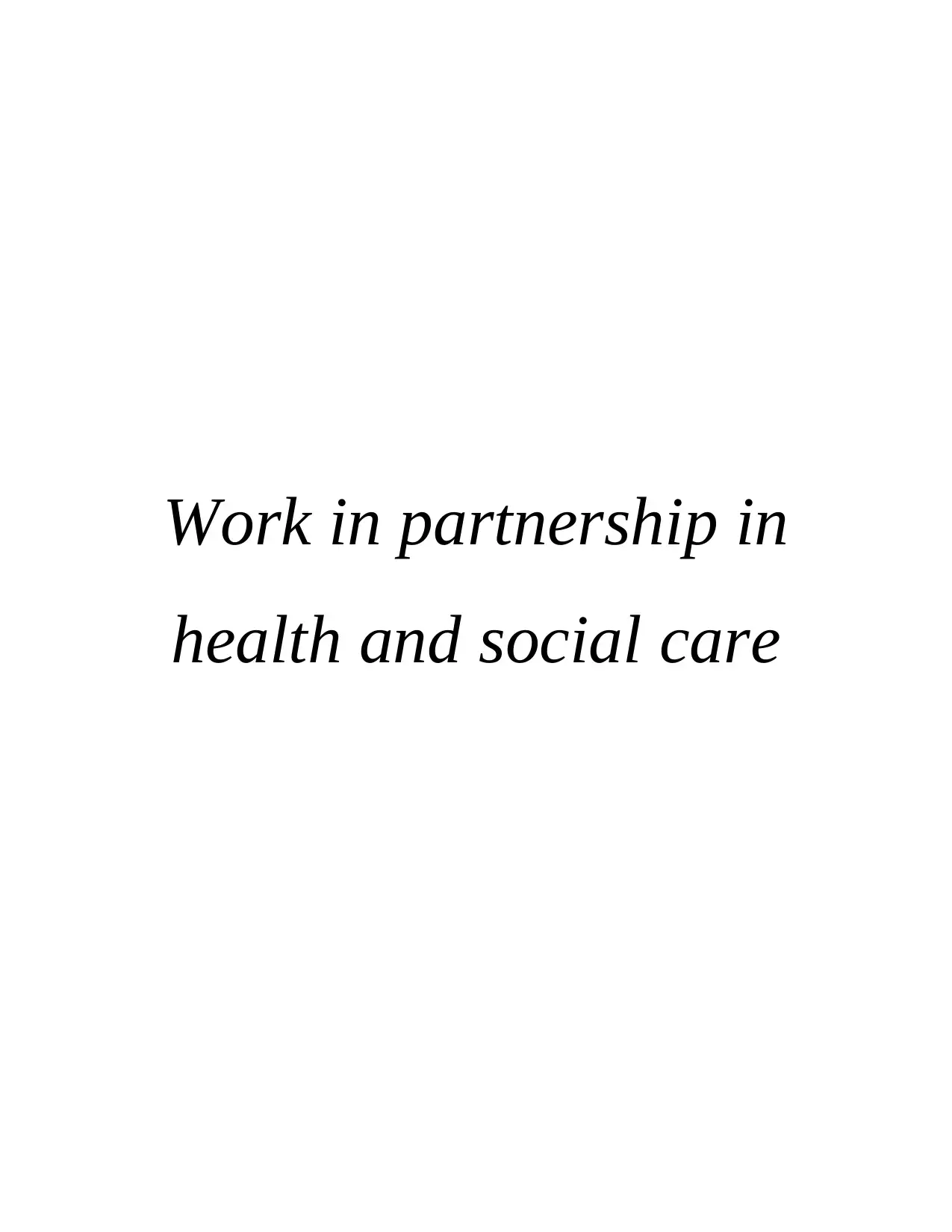
Work in partnership in
health and social care
health and social care
Paraphrase This Document
Need a fresh take? Get an instant paraphrase of this document with our AI Paraphraser
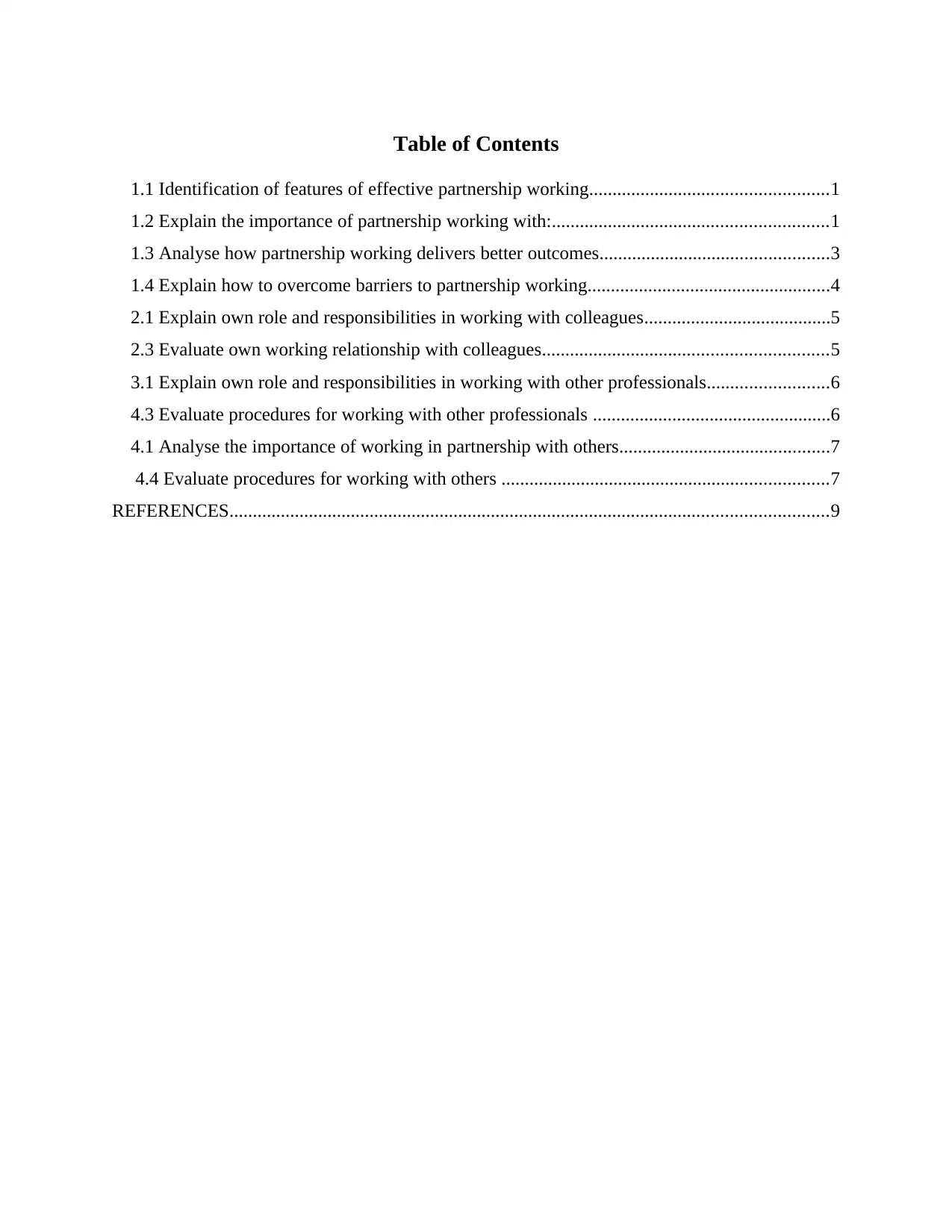
Table of Contents
1.1 Identification of features of effective partnership working...................................................1
1.2 Explain the importance of partnership working with:...........................................................1
1.3 Analyse how partnership working delivers better outcomes.................................................3
1.4 Explain how to overcome barriers to partnership working....................................................4
2.1 Explain own role and responsibilities in working with colleagues........................................5
2.3 Evaluate own working relationship with colleagues.............................................................5
3.1 Explain own role and responsibilities in working with other professionals..........................6
4.3 Evaluate procedures for working with other professionals ...................................................6
4.1 Analyse the importance of working in partnership with others.............................................7
4.4 Evaluate procedures for working with others ......................................................................7
REFERENCES................................................................................................................................9
1.1 Identification of features of effective partnership working...................................................1
1.2 Explain the importance of partnership working with:...........................................................1
1.3 Analyse how partnership working delivers better outcomes.................................................3
1.4 Explain how to overcome barriers to partnership working....................................................4
2.1 Explain own role and responsibilities in working with colleagues........................................5
2.3 Evaluate own working relationship with colleagues.............................................................5
3.1 Explain own role and responsibilities in working with other professionals..........................6
4.3 Evaluate procedures for working with other professionals ...................................................6
4.1 Analyse the importance of working in partnership with others.............................................7
4.4 Evaluate procedures for working with others ......................................................................7
REFERENCES................................................................................................................................9
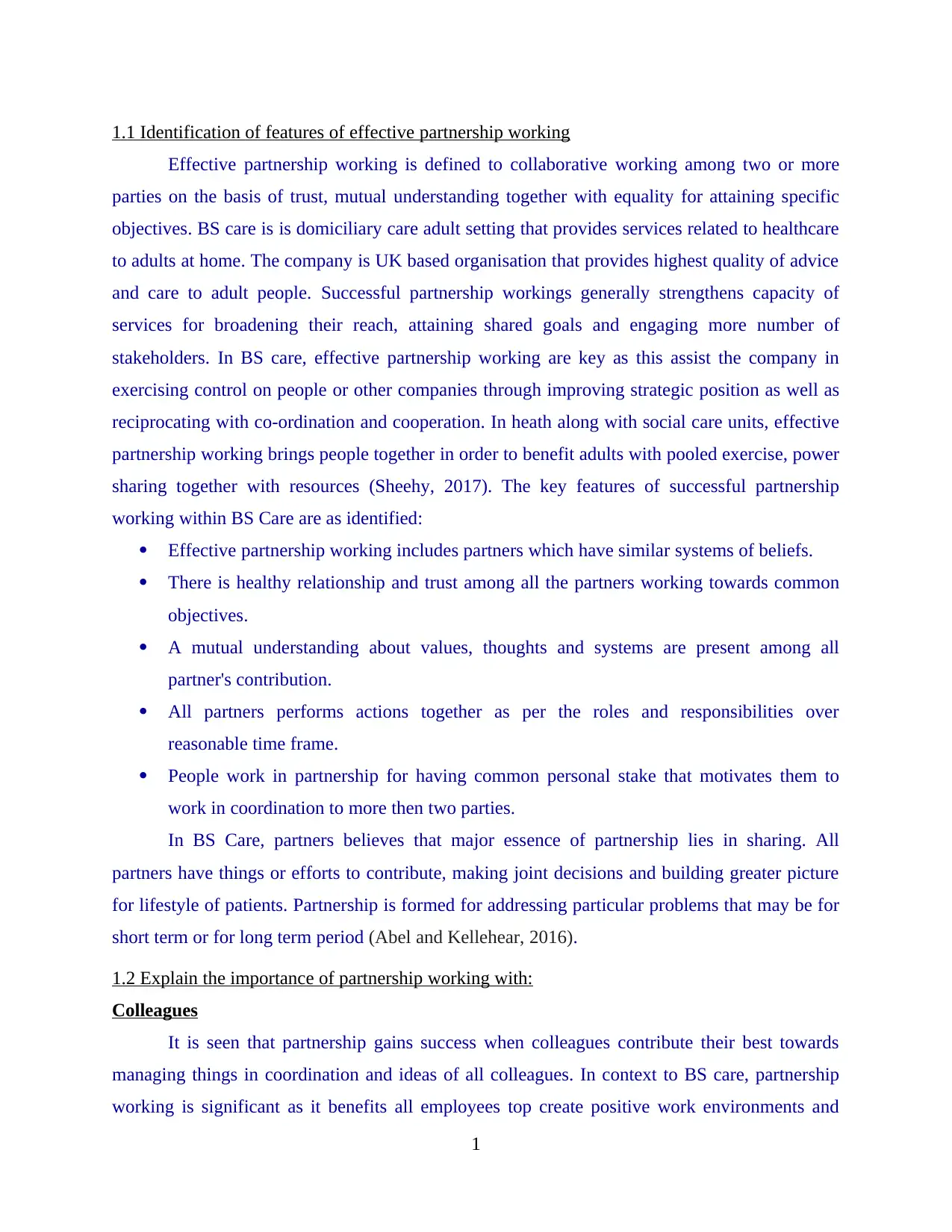
1.1 Identification of features of effective partnership working
Effective partnership working is defined to collaborative working among two or more
parties on the basis of trust, mutual understanding together with equality for attaining specific
objectives. BS care is is domiciliary care adult setting that provides services related to healthcare
to adults at home. The company is UK based organisation that provides highest quality of advice
and care to adult people. Successful partnership workings generally strengthens capacity of
services for broadening their reach, attaining shared goals and engaging more number of
stakeholders. In BS care, effective partnership working are key as this assist the company in
exercising control on people or other companies through improving strategic position as well as
reciprocating with co-ordination and cooperation. In heath along with social care units, effective
partnership working brings people together in order to benefit adults with pooled exercise, power
sharing together with resources (Sheehy, 2017). The key features of successful partnership
working within BS Care are as identified:
Effective partnership working includes partners which have similar systems of beliefs.
There is healthy relationship and trust among all the partners working towards common
objectives.
A mutual understanding about values, thoughts and systems are present among all
partner's contribution.
All partners performs actions together as per the roles and responsibilities over
reasonable time frame.
People work in partnership for having common personal stake that motivates them to
work in coordination to more then two parties.
In BS Care, partners believes that major essence of partnership lies in sharing. All
partners have things or efforts to contribute, making joint decisions and building greater picture
for lifestyle of patients. Partnership is formed for addressing particular problems that may be for
short term or for long term period (Abel and Kellehear, 2016).
1.2 Explain the importance of partnership working with:
Colleagues
It is seen that partnership gains success when colleagues contribute their best towards
managing things in coordination and ideas of all colleagues. In context to BS care, partnership
working is significant as it benefits all employees top create positive work environments and
1
Effective partnership working is defined to collaborative working among two or more
parties on the basis of trust, mutual understanding together with equality for attaining specific
objectives. BS care is is domiciliary care adult setting that provides services related to healthcare
to adults at home. The company is UK based organisation that provides highest quality of advice
and care to adult people. Successful partnership workings generally strengthens capacity of
services for broadening their reach, attaining shared goals and engaging more number of
stakeholders. In BS care, effective partnership working are key as this assist the company in
exercising control on people or other companies through improving strategic position as well as
reciprocating with co-ordination and cooperation. In heath along with social care units, effective
partnership working brings people together in order to benefit adults with pooled exercise, power
sharing together with resources (Sheehy, 2017). The key features of successful partnership
working within BS Care are as identified:
Effective partnership working includes partners which have similar systems of beliefs.
There is healthy relationship and trust among all the partners working towards common
objectives.
A mutual understanding about values, thoughts and systems are present among all
partner's contribution.
All partners performs actions together as per the roles and responsibilities over
reasonable time frame.
People work in partnership for having common personal stake that motivates them to
work in coordination to more then two parties.
In BS Care, partners believes that major essence of partnership lies in sharing. All
partners have things or efforts to contribute, making joint decisions and building greater picture
for lifestyle of patients. Partnership is formed for addressing particular problems that may be for
short term or for long term period (Abel and Kellehear, 2016).
1.2 Explain the importance of partnership working with:
Colleagues
It is seen that partnership gains success when colleagues contribute their best towards
managing things in coordination and ideas of all colleagues. In context to BS care, partnership
working is significant as it benefits all employees top create positive work environments and
1
⊘ This is a preview!⊘
Do you want full access?
Subscribe today to unlock all pages.

Trusted by 1+ million students worldwide
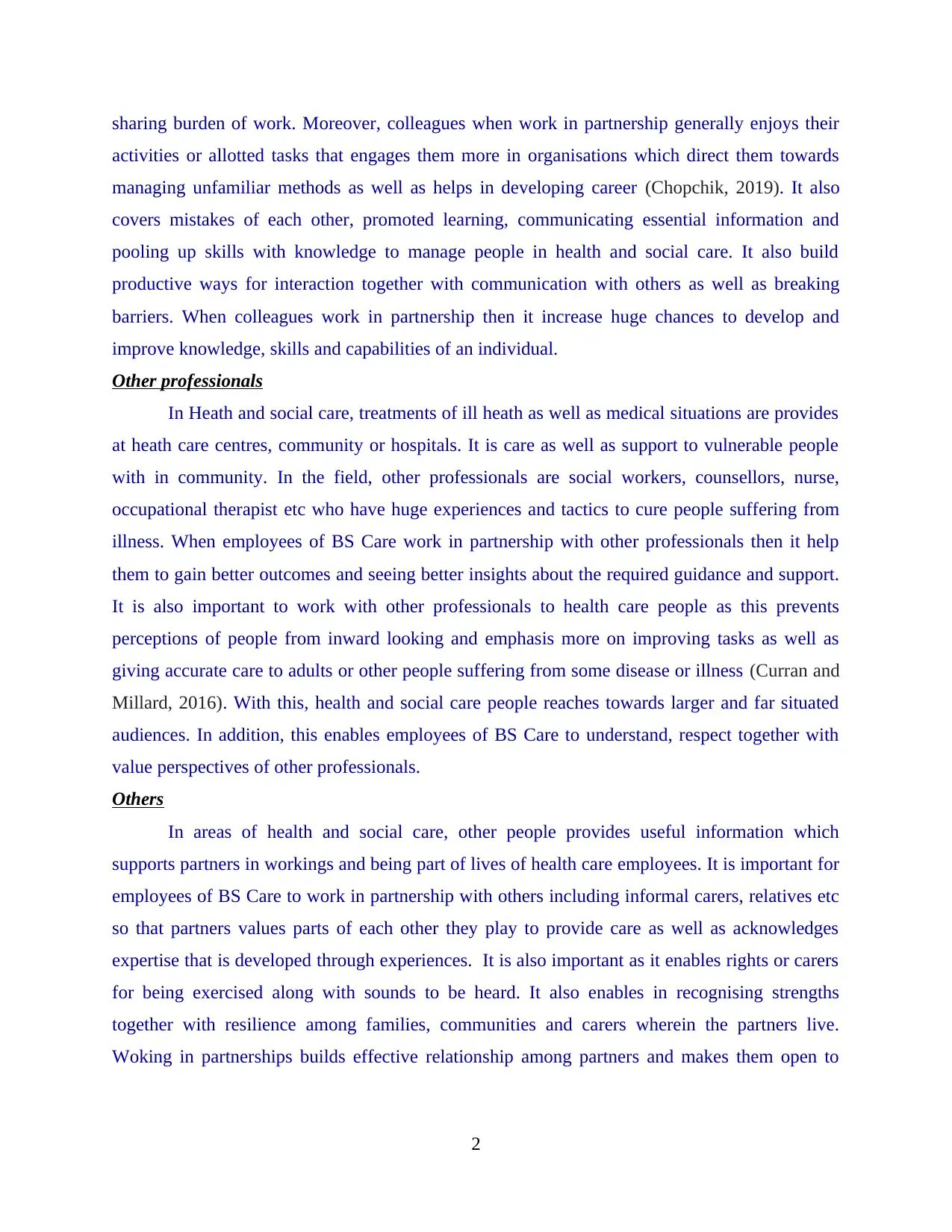
sharing burden of work. Moreover, colleagues when work in partnership generally enjoys their
activities or allotted tasks that engages them more in organisations which direct them towards
managing unfamiliar methods as well as helps in developing career (Chopchik, 2019). It also
covers mistakes of each other, promoted learning, communicating essential information and
pooling up skills with knowledge to manage people in health and social care. It also build
productive ways for interaction together with communication with others as well as breaking
barriers. When colleagues work in partnership then it increase huge chances to develop and
improve knowledge, skills and capabilities of an individual.
Other professionals
In Heath and social care, treatments of ill heath as well as medical situations are provides
at heath care centres, community or hospitals. It is care as well as support to vulnerable people
with in community. In the field, other professionals are social workers, counsellors, nurse,
occupational therapist etc who have huge experiences and tactics to cure people suffering from
illness. When employees of BS Care work in partnership with other professionals then it help
them to gain better outcomes and seeing better insights about the required guidance and support.
It is also important to work with other professionals to health care people as this prevents
perceptions of people from inward looking and emphasis more on improving tasks as well as
giving accurate care to adults or other people suffering from some disease or illness (Curran and
Millard, 2016). With this, health and social care people reaches towards larger and far situated
audiences. In addition, this enables employees of BS Care to understand, respect together with
value perspectives of other professionals.
Others
In areas of health and social care, other people provides useful information which
supports partners in workings and being part of lives of health care employees. It is important for
employees of BS Care to work in partnership with others including informal carers, relatives etc
so that partners values parts of each other they play to provide care as well as acknowledges
expertise that is developed through experiences. It is also important as it enables rights or carers
for being exercised along with sounds to be heard. It also enables in recognising strengths
together with resilience among families, communities and carers wherein the partners live.
Woking in partnerships builds effective relationship among partners and makes them open to
2
activities or allotted tasks that engages them more in organisations which direct them towards
managing unfamiliar methods as well as helps in developing career (Chopchik, 2019). It also
covers mistakes of each other, promoted learning, communicating essential information and
pooling up skills with knowledge to manage people in health and social care. It also build
productive ways for interaction together with communication with others as well as breaking
barriers. When colleagues work in partnership then it increase huge chances to develop and
improve knowledge, skills and capabilities of an individual.
Other professionals
In Heath and social care, treatments of ill heath as well as medical situations are provides
at heath care centres, community or hospitals. It is care as well as support to vulnerable people
with in community. In the field, other professionals are social workers, counsellors, nurse,
occupational therapist etc who have huge experiences and tactics to cure people suffering from
illness. When employees of BS Care work in partnership with other professionals then it help
them to gain better outcomes and seeing better insights about the required guidance and support.
It is also important to work with other professionals to health care people as this prevents
perceptions of people from inward looking and emphasis more on improving tasks as well as
giving accurate care to adults or other people suffering from some disease or illness (Curran and
Millard, 2016). With this, health and social care people reaches towards larger and far situated
audiences. In addition, this enables employees of BS Care to understand, respect together with
value perspectives of other professionals.
Others
In areas of health and social care, other people provides useful information which
supports partners in workings and being part of lives of health care employees. It is important for
employees of BS Care to work in partnership with others including informal carers, relatives etc
so that partners values parts of each other they play to provide care as well as acknowledges
expertise that is developed through experiences. It is also important as it enables rights or carers
for being exercised along with sounds to be heard. It also enables in recognising strengths
together with resilience among families, communities and carers wherein the partners live.
Woking in partnerships builds effective relationship among partners and makes them open to
2
Paraphrase This Document
Need a fresh take? Get an instant paraphrase of this document with our AI Paraphraser
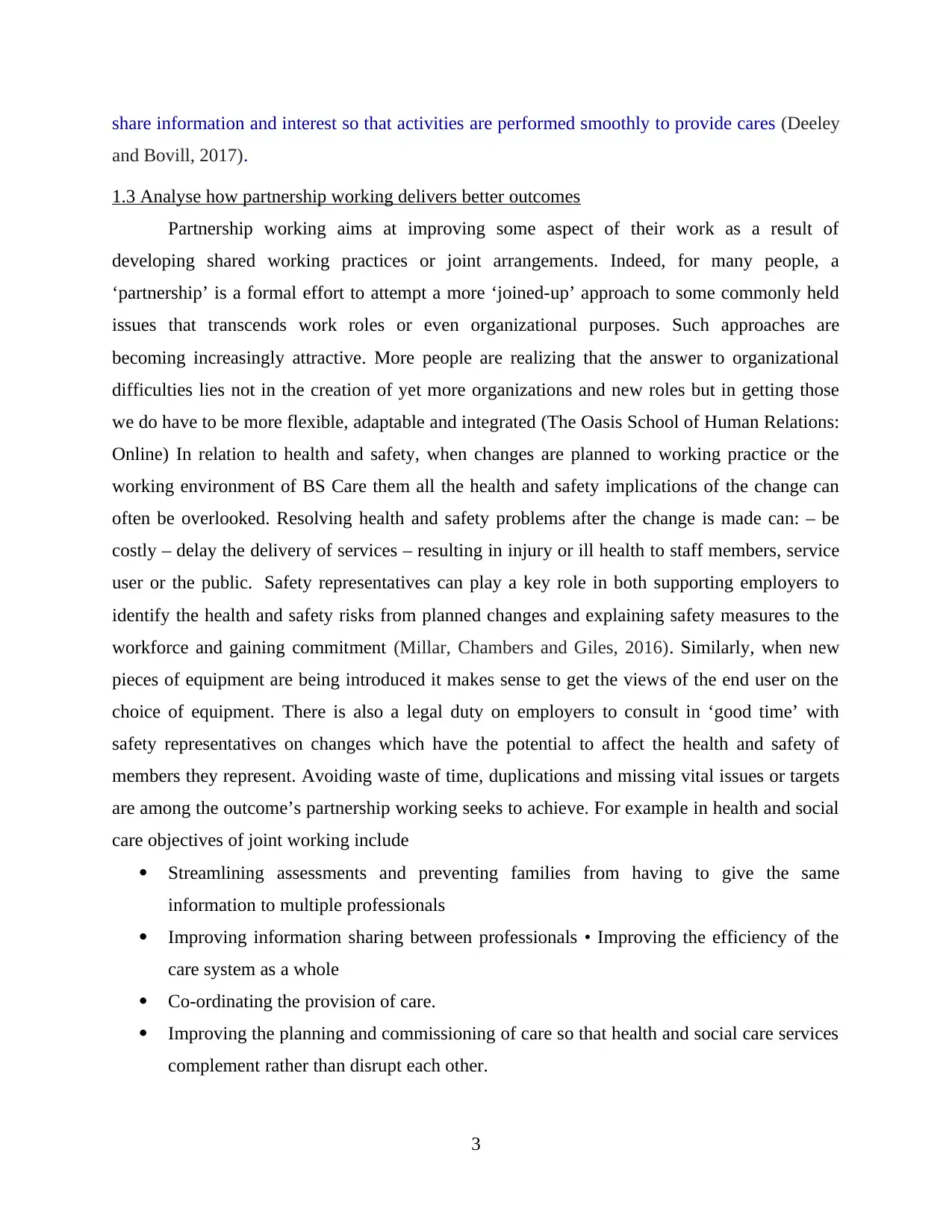
share information and interest so that activities are performed smoothly to provide cares (Deeley
and Bovill, 2017).
1.3 Analyse how partnership working delivers better outcomes
Partnership working aims at improving some aspect of their work as a result of
developing shared working practices or joint arrangements. Indeed, for many people, a
‘partnership’ is a formal effort to attempt a more ‘joined-up’ approach to some commonly held
issues that transcends work roles or even organizational purposes. Such approaches are
becoming increasingly attractive. More people are realizing that the answer to organizational
difficulties lies not in the creation of yet more organizations and new roles but in getting those
we do have to be more flexible, adaptable and integrated (The Oasis School of Human Relations:
Online) In relation to health and safety, when changes are planned to working practice or the
working environment of BS Care them all the health and safety implications of the change can
often be overlooked. Resolving health and safety problems after the change is made can: – be
costly – delay the delivery of services – resulting in injury or ill health to staff members, service
user or the public. Safety representatives can play a key role in both supporting employers to
identify the health and safety risks from planned changes and explaining safety measures to the
workforce and gaining commitment (Millar, Chambers and Giles, 2016). Similarly, when new
pieces of equipment are being introduced it makes sense to get the views of the end user on the
choice of equipment. There is also a legal duty on employers to consult in ‘good time’ with
safety representatives on changes which have the potential to affect the health and safety of
members they represent. Avoiding waste of time, duplications and missing vital issues or targets
are among the outcome’s partnership working seeks to achieve. For example in health and social
care objectives of joint working include
Streamlining assessments and preventing families from having to give the same
information to multiple professionals
Improving information sharing between professionals • Improving the efficiency of the
care system as a whole
Co-ordinating the provision of care.
Improving the planning and commissioning of care so that health and social care services
complement rather than disrupt each other.
3
and Bovill, 2017).
1.3 Analyse how partnership working delivers better outcomes
Partnership working aims at improving some aspect of their work as a result of
developing shared working practices or joint arrangements. Indeed, for many people, a
‘partnership’ is a formal effort to attempt a more ‘joined-up’ approach to some commonly held
issues that transcends work roles or even organizational purposes. Such approaches are
becoming increasingly attractive. More people are realizing that the answer to organizational
difficulties lies not in the creation of yet more organizations and new roles but in getting those
we do have to be more flexible, adaptable and integrated (The Oasis School of Human Relations:
Online) In relation to health and safety, when changes are planned to working practice or the
working environment of BS Care them all the health and safety implications of the change can
often be overlooked. Resolving health and safety problems after the change is made can: – be
costly – delay the delivery of services – resulting in injury or ill health to staff members, service
user or the public. Safety representatives can play a key role in both supporting employers to
identify the health and safety risks from planned changes and explaining safety measures to the
workforce and gaining commitment (Millar, Chambers and Giles, 2016). Similarly, when new
pieces of equipment are being introduced it makes sense to get the views of the end user on the
choice of equipment. There is also a legal duty on employers to consult in ‘good time’ with
safety representatives on changes which have the potential to affect the health and safety of
members they represent. Avoiding waste of time, duplications and missing vital issues or targets
are among the outcome’s partnership working seeks to achieve. For example in health and social
care objectives of joint working include
Streamlining assessments and preventing families from having to give the same
information to multiple professionals
Improving information sharing between professionals • Improving the efficiency of the
care system as a whole
Co-ordinating the provision of care.
Improving the planning and commissioning of care so that health and social care services
complement rather than disrupt each other.
3
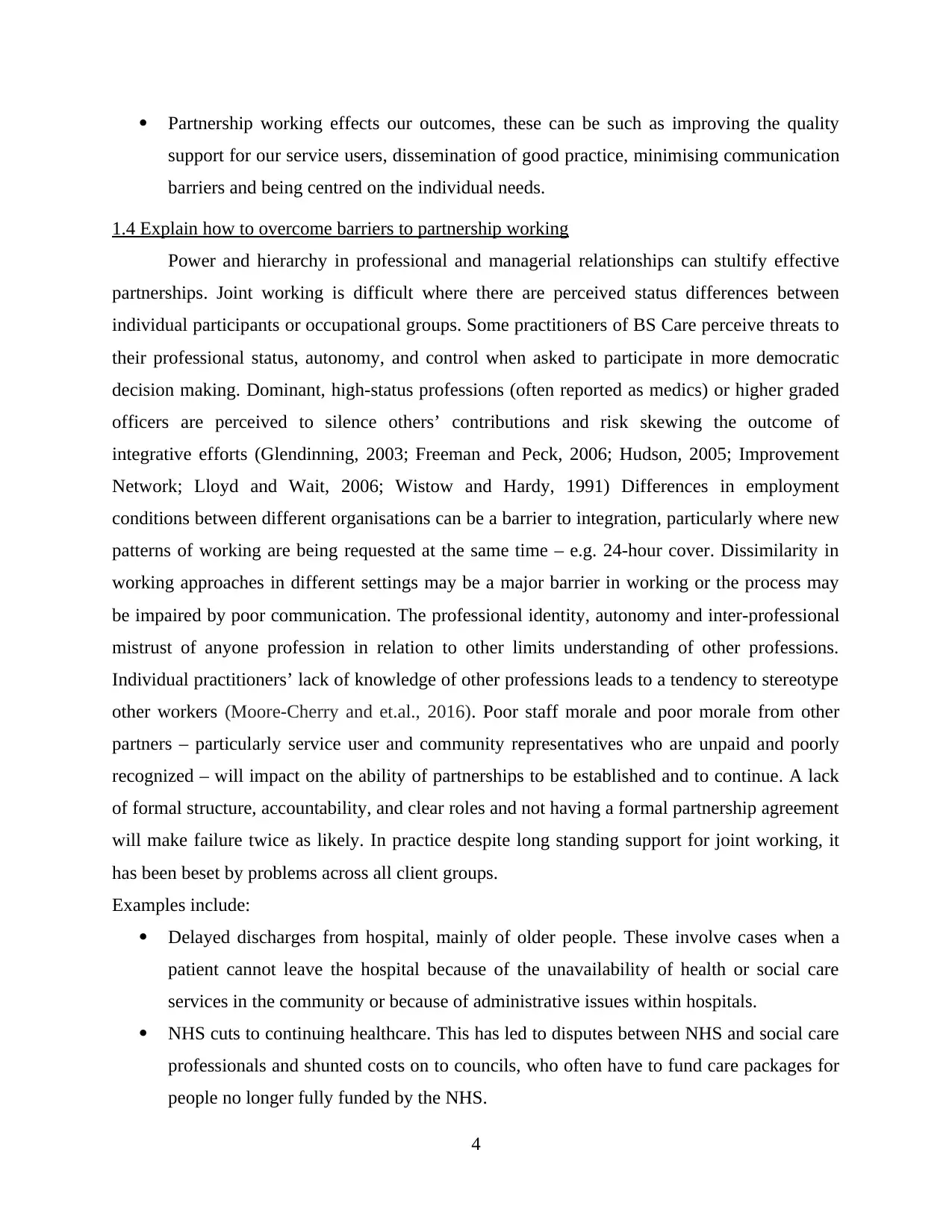
Partnership working effects our outcomes, these can be such as improving the quality
support for our service users, dissemination of good practice, minimising communication
barriers and being centred on the individual needs.
1.4 Explain how to overcome barriers to partnership working
Power and hierarchy in professional and managerial relationships can stultify effective
partnerships. Joint working is difficult where there are perceived status differences between
individual participants or occupational groups. Some practitioners of BS Care perceive threats to
their professional status, autonomy, and control when asked to participate in more democratic
decision making. Dominant, high-status professions (often reported as medics) or higher graded
officers are perceived to silence others’ contributions and risk skewing the outcome of
integrative efforts (Glendinning, 2003; Freeman and Peck, 2006; Hudson, 2005; Improvement
Network; Lloyd and Wait, 2006; Wistow and Hardy, 1991) Differences in employment
conditions between different organisations can be a barrier to integration, particularly where new
patterns of working are being requested at the same time – e.g. 24-hour cover. Dissimilarity in
working approaches in different settings may be a major barrier in working or the process may
be impaired by poor communication. The professional identity, autonomy and inter-professional
mistrust of anyone profession in relation to other limits understanding of other professions.
Individual practitioners’ lack of knowledge of other professions leads to a tendency to stereotype
other workers (Moore-Cherry and et.al., 2016). Poor staff morale and poor morale from other
partners – particularly service user and community representatives who are unpaid and poorly
recognized – will impact on the ability of partnerships to be established and to continue. A lack
of formal structure, accountability, and clear roles and not having a formal partnership agreement
will make failure twice as likely. In practice despite long standing support for joint working, it
has been beset by problems across all client groups.
Examples include:
Delayed discharges from hospital, mainly of older people. These involve cases when a
patient cannot leave the hospital because of the unavailability of health or social care
services in the community or because of administrative issues within hospitals.
NHS cuts to continuing healthcare. This has led to disputes between NHS and social care
professionals and shunted costs on to councils, who often have to fund care packages for
people no longer fully funded by the NHS.
4
support for our service users, dissemination of good practice, minimising communication
barriers and being centred on the individual needs.
1.4 Explain how to overcome barriers to partnership working
Power and hierarchy in professional and managerial relationships can stultify effective
partnerships. Joint working is difficult where there are perceived status differences between
individual participants or occupational groups. Some practitioners of BS Care perceive threats to
their professional status, autonomy, and control when asked to participate in more democratic
decision making. Dominant, high-status professions (often reported as medics) or higher graded
officers are perceived to silence others’ contributions and risk skewing the outcome of
integrative efforts (Glendinning, 2003; Freeman and Peck, 2006; Hudson, 2005; Improvement
Network; Lloyd and Wait, 2006; Wistow and Hardy, 1991) Differences in employment
conditions between different organisations can be a barrier to integration, particularly where new
patterns of working are being requested at the same time – e.g. 24-hour cover. Dissimilarity in
working approaches in different settings may be a major barrier in working or the process may
be impaired by poor communication. The professional identity, autonomy and inter-professional
mistrust of anyone profession in relation to other limits understanding of other professions.
Individual practitioners’ lack of knowledge of other professions leads to a tendency to stereotype
other workers (Moore-Cherry and et.al., 2016). Poor staff morale and poor morale from other
partners – particularly service user and community representatives who are unpaid and poorly
recognized – will impact on the ability of partnerships to be established and to continue. A lack
of formal structure, accountability, and clear roles and not having a formal partnership agreement
will make failure twice as likely. In practice despite long standing support for joint working, it
has been beset by problems across all client groups.
Examples include:
Delayed discharges from hospital, mainly of older people. These involve cases when a
patient cannot leave the hospital because of the unavailability of health or social care
services in the community or because of administrative issues within hospitals.
NHS cuts to continuing healthcare. This has led to disputes between NHS and social care
professionals and shunted costs on to councils, who often have to fund care packages for
people no longer fully funded by the NHS.
4
⊘ This is a preview!⊘
Do you want full access?
Subscribe today to unlock all pages.

Trusted by 1+ million students worldwide
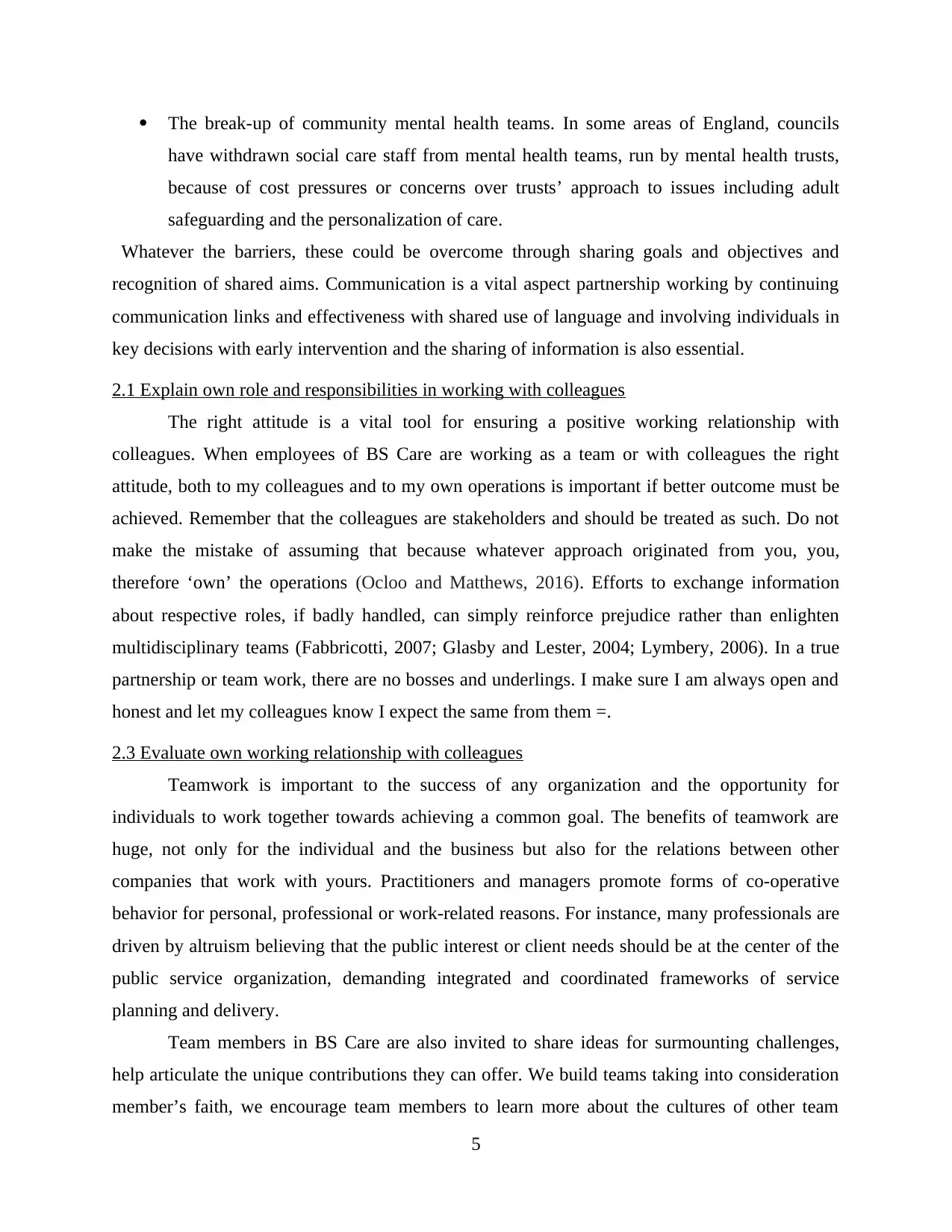
The break-up of community mental health teams. In some areas of England, councils
have withdrawn social care staff from mental health teams, run by mental health trusts,
because of cost pressures or concerns over trusts’ approach to issues including adult
safeguarding and the personalization of care.
Whatever the barriers, these could be overcome through sharing goals and objectives and
recognition of shared aims. Communication is a vital aspect partnership working by continuing
communication links and effectiveness with shared use of language and involving individuals in
key decisions with early intervention and the sharing of information is also essential.
2.1 Explain own role and responsibilities in working with colleagues
The right attitude is a vital tool for ensuring a positive working relationship with
colleagues. When employees of BS Care are working as a team or with colleagues the right
attitude, both to my colleagues and to my own operations is important if better outcome must be
achieved. Remember that the colleagues are stakeholders and should be treated as such. Do not
make the mistake of assuming that because whatever approach originated from you, you,
therefore ‘own’ the operations (Ocloo and Matthews, 2016). Efforts to exchange information
about respective roles, if badly handled, can simply reinforce prejudice rather than enlighten
multidisciplinary teams (Fabbricotti, 2007; Glasby and Lester, 2004; Lymbery, 2006). In a true
partnership or team work, there are no bosses and underlings. I make sure I am always open and
honest and let my colleagues know I expect the same from them =.
2.3 Evaluate own working relationship with colleagues
Teamwork is important to the success of any organization and the opportunity for
individuals to work together towards achieving a common goal. The benefits of teamwork are
huge, not only for the individual and the business but also for the relations between other
companies that work with yours. Practitioners and managers promote forms of co-operative
behavior for personal, professional or work-related reasons. For instance, many professionals are
driven by altruism believing that the public interest or client needs should be at the center of the
public service organization, demanding integrated and coordinated frameworks of service
planning and delivery.
Team members in BS Care are also invited to share ideas for surmounting challenges,
help articulate the unique contributions they can offer. We build teams taking into consideration
member’s faith, we encourage team members to learn more about the cultures of other team
5
have withdrawn social care staff from mental health teams, run by mental health trusts,
because of cost pressures or concerns over trusts’ approach to issues including adult
safeguarding and the personalization of care.
Whatever the barriers, these could be overcome through sharing goals and objectives and
recognition of shared aims. Communication is a vital aspect partnership working by continuing
communication links and effectiveness with shared use of language and involving individuals in
key decisions with early intervention and the sharing of information is also essential.
2.1 Explain own role and responsibilities in working with colleagues
The right attitude is a vital tool for ensuring a positive working relationship with
colleagues. When employees of BS Care are working as a team or with colleagues the right
attitude, both to my colleagues and to my own operations is important if better outcome must be
achieved. Remember that the colleagues are stakeholders and should be treated as such. Do not
make the mistake of assuming that because whatever approach originated from you, you,
therefore ‘own’ the operations (Ocloo and Matthews, 2016). Efforts to exchange information
about respective roles, if badly handled, can simply reinforce prejudice rather than enlighten
multidisciplinary teams (Fabbricotti, 2007; Glasby and Lester, 2004; Lymbery, 2006). In a true
partnership or team work, there are no bosses and underlings. I make sure I am always open and
honest and let my colleagues know I expect the same from them =.
2.3 Evaluate own working relationship with colleagues
Teamwork is important to the success of any organization and the opportunity for
individuals to work together towards achieving a common goal. The benefits of teamwork are
huge, not only for the individual and the business but also for the relations between other
companies that work with yours. Practitioners and managers promote forms of co-operative
behavior for personal, professional or work-related reasons. For instance, many professionals are
driven by altruism believing that the public interest or client needs should be at the center of the
public service organization, demanding integrated and coordinated frameworks of service
planning and delivery.
Team members in BS Care are also invited to share ideas for surmounting challenges,
help articulate the unique contributions they can offer. We build teams taking into consideration
member’s faith, we encourage team members to learn more about the cultures of other team
5
Paraphrase This Document
Need a fresh take? Get an instant paraphrase of this document with our AI Paraphraser
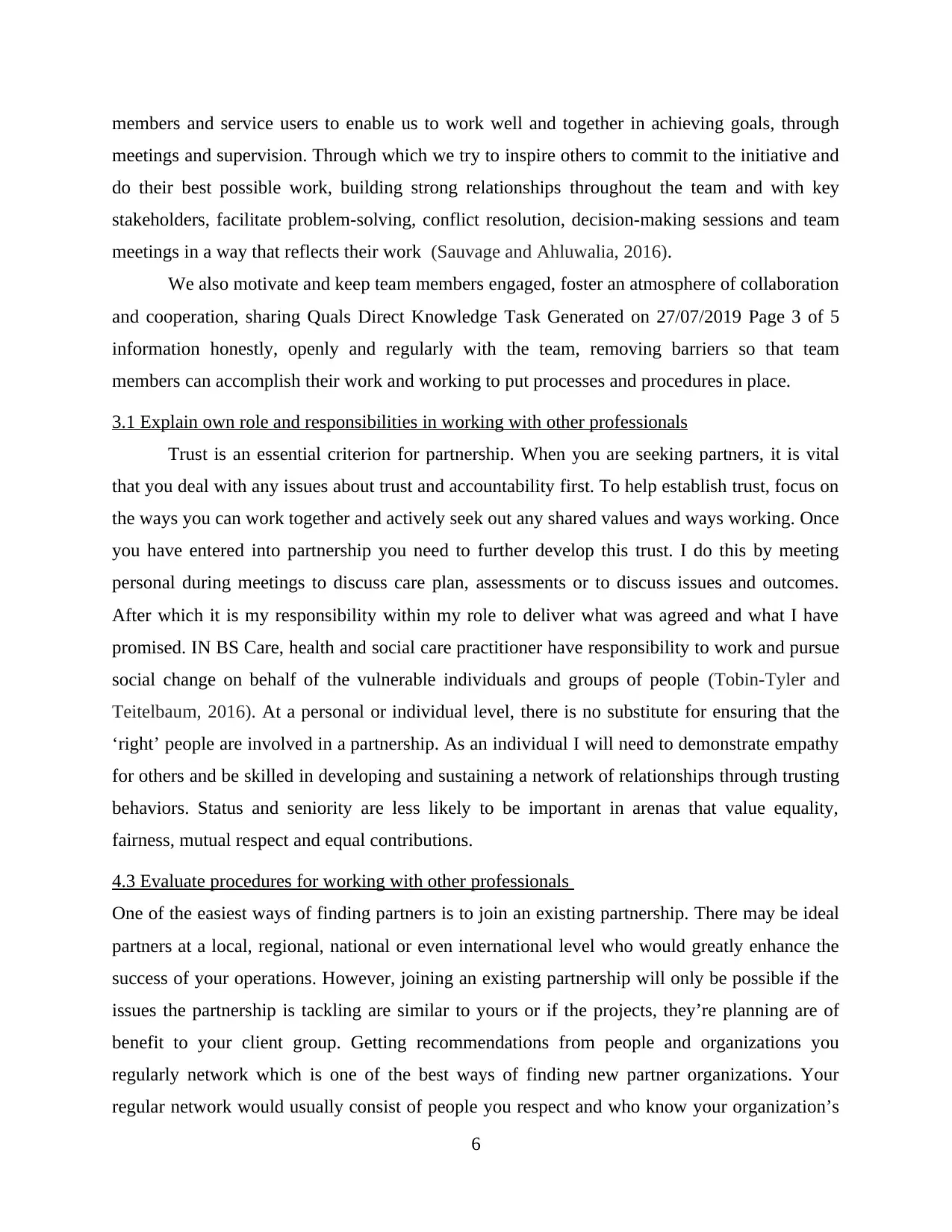
members and service users to enable us to work well and together in achieving goals, through
meetings and supervision. Through which we try to inspire others to commit to the initiative and
do their best possible work, building strong relationships throughout the team and with key
stakeholders, facilitate problem-solving, conflict resolution, decision-making sessions and team
meetings in a way that reflects their work (Sauvage and Ahluwalia, 2016).
We also motivate and keep team members engaged, foster an atmosphere of collaboration
and cooperation, sharing Quals Direct Knowledge Task Generated on 27/07/2019 Page 3 of 5
information honestly, openly and regularly with the team, removing barriers so that team
members can accomplish their work and working to put processes and procedures in place.
3.1 Explain own role and responsibilities in working with other professionals
Trust is an essential criterion for partnership. When you are seeking partners, it is vital
that you deal with any issues about trust and accountability first. To help establish trust, focus on
the ways you can work together and actively seek out any shared values and ways working. Once
you have entered into partnership you need to further develop this trust. I do this by meeting
personal during meetings to discuss care plan, assessments or to discuss issues and outcomes.
After which it is my responsibility within my role to deliver what was agreed and what I have
promised. IN BS Care, health and social care practitioner have responsibility to work and pursue
social change on behalf of the vulnerable individuals and groups of people (Tobin-Tyler and
Teitelbaum, 2016). At a personal or individual level, there is no substitute for ensuring that the
‘right’ people are involved in a partnership. As an individual I will need to demonstrate empathy
for others and be skilled in developing and sustaining a network of relationships through trusting
behaviors. Status and seniority are less likely to be important in arenas that value equality,
fairness, mutual respect and equal contributions.
4.3 Evaluate procedures for working with other professionals
One of the easiest ways of finding partners is to join an existing partnership. There may be ideal
partners at a local, regional, national or even international level who would greatly enhance the
success of your operations. However, joining an existing partnership will only be possible if the
issues the partnership is tackling are similar to yours or if the projects, they’re planning are of
benefit to your client group. Getting recommendations from people and organizations you
regularly network which is one of the best ways of finding new partner organizations. Your
regular network would usually consist of people you respect and who know your organization’s
6
meetings and supervision. Through which we try to inspire others to commit to the initiative and
do their best possible work, building strong relationships throughout the team and with key
stakeholders, facilitate problem-solving, conflict resolution, decision-making sessions and team
meetings in a way that reflects their work (Sauvage and Ahluwalia, 2016).
We also motivate and keep team members engaged, foster an atmosphere of collaboration
and cooperation, sharing Quals Direct Knowledge Task Generated on 27/07/2019 Page 3 of 5
information honestly, openly and regularly with the team, removing barriers so that team
members can accomplish their work and working to put processes and procedures in place.
3.1 Explain own role and responsibilities in working with other professionals
Trust is an essential criterion for partnership. When you are seeking partners, it is vital
that you deal with any issues about trust and accountability first. To help establish trust, focus on
the ways you can work together and actively seek out any shared values and ways working. Once
you have entered into partnership you need to further develop this trust. I do this by meeting
personal during meetings to discuss care plan, assessments or to discuss issues and outcomes.
After which it is my responsibility within my role to deliver what was agreed and what I have
promised. IN BS Care, health and social care practitioner have responsibility to work and pursue
social change on behalf of the vulnerable individuals and groups of people (Tobin-Tyler and
Teitelbaum, 2016). At a personal or individual level, there is no substitute for ensuring that the
‘right’ people are involved in a partnership. As an individual I will need to demonstrate empathy
for others and be skilled in developing and sustaining a network of relationships through trusting
behaviors. Status and seniority are less likely to be important in arenas that value equality,
fairness, mutual respect and equal contributions.
4.3 Evaluate procedures for working with other professionals
One of the easiest ways of finding partners is to join an existing partnership. There may be ideal
partners at a local, regional, national or even international level who would greatly enhance the
success of your operations. However, joining an existing partnership will only be possible if the
issues the partnership is tackling are similar to yours or if the projects, they’re planning are of
benefit to your client group. Getting recommendations from people and organizations you
regularly network which is one of the best ways of finding new partner organizations. Your
regular network would usually consist of people you respect and who know your organization’s
6
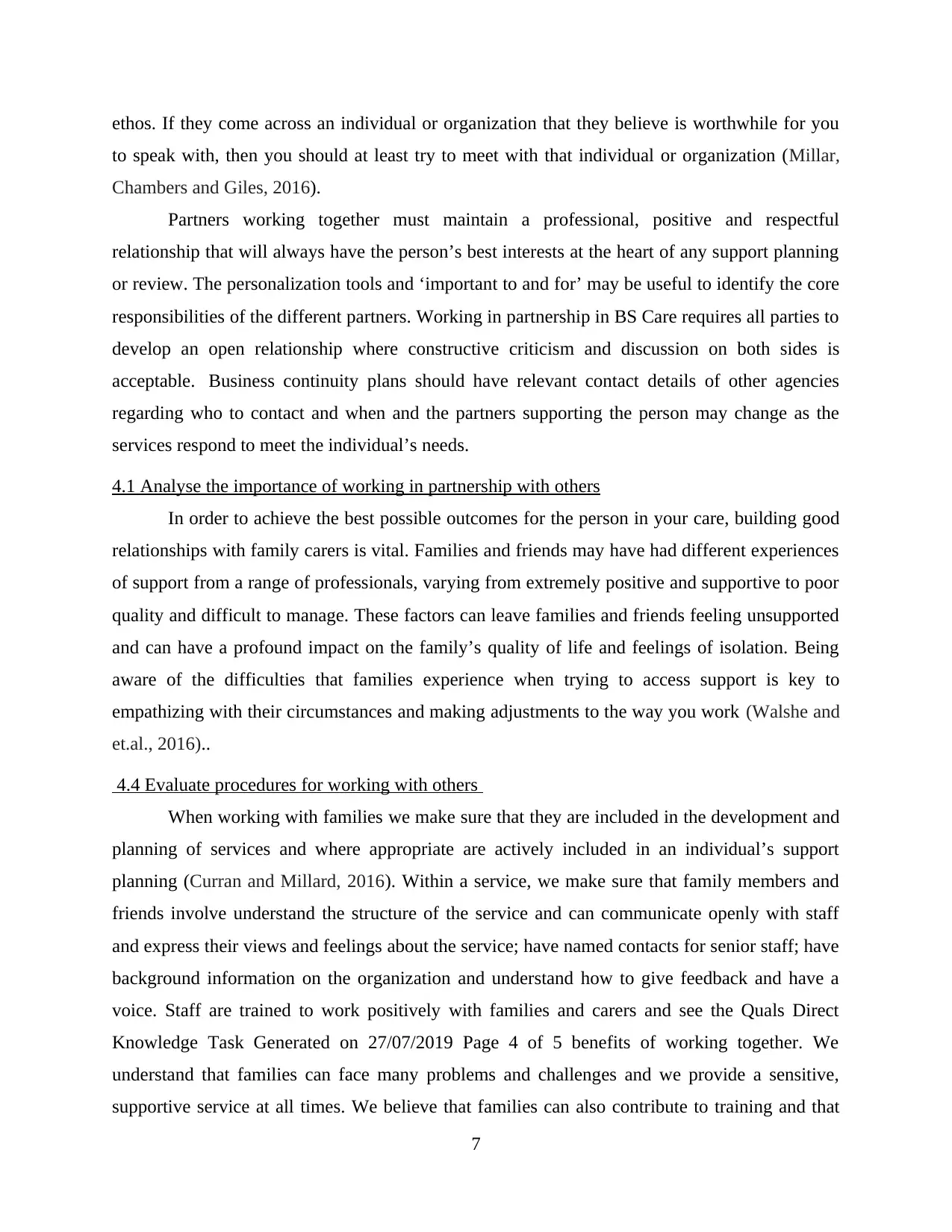
ethos. If they come across an individual or organization that they believe is worthwhile for you
to speak with, then you should at least try to meet with that individual or organization (Millar,
Chambers and Giles, 2016).
Partners working together must maintain a professional, positive and respectful
relationship that will always have the person’s best interests at the heart of any support planning
or review. The personalization tools and ‘important to and for’ may be useful to identify the core
responsibilities of the different partners. Working in partnership in BS Care requires all parties to
develop an open relationship where constructive criticism and discussion on both sides is
acceptable. Business continuity plans should have relevant contact details of other agencies
regarding who to contact and when and the partners supporting the person may change as the
services respond to meet the individual’s needs.
4.1 Analyse the importance of working in partnership with others
In order to achieve the best possible outcomes for the person in your care, building good
relationships with family carers is vital. Families and friends may have had different experiences
of support from a range of professionals, varying from extremely positive and supportive to poor
quality and difficult to manage. These factors can leave families and friends feeling unsupported
and can have a profound impact on the family’s quality of life and feelings of isolation. Being
aware of the difficulties that families experience when trying to access support is key to
empathizing with their circumstances and making adjustments to the way you work (Walshe and
et.al., 2016)..
4.4 Evaluate procedures for working with others
When working with families we make sure that they are included in the development and
planning of services and where appropriate are actively included in an individual’s support
planning (Curran and Millard, 2016). Within a service, we make sure that family members and
friends involve understand the structure of the service and can communicate openly with staff
and express their views and feelings about the service; have named contacts for senior staff; have
background information on the organization and understand how to give feedback and have a
voice. Staff are trained to work positively with families and carers and see the Quals Direct
Knowledge Task Generated on 27/07/2019 Page 4 of 5 benefits of working together. We
understand that families can face many problems and challenges and we provide a sensitive,
supportive service at all times. We believe that families can also contribute to training and that
7
to speak with, then you should at least try to meet with that individual or organization (Millar,
Chambers and Giles, 2016).
Partners working together must maintain a professional, positive and respectful
relationship that will always have the person’s best interests at the heart of any support planning
or review. The personalization tools and ‘important to and for’ may be useful to identify the core
responsibilities of the different partners. Working in partnership in BS Care requires all parties to
develop an open relationship where constructive criticism and discussion on both sides is
acceptable. Business continuity plans should have relevant contact details of other agencies
regarding who to contact and when and the partners supporting the person may change as the
services respond to meet the individual’s needs.
4.1 Analyse the importance of working in partnership with others
In order to achieve the best possible outcomes for the person in your care, building good
relationships with family carers is vital. Families and friends may have had different experiences
of support from a range of professionals, varying from extremely positive and supportive to poor
quality and difficult to manage. These factors can leave families and friends feeling unsupported
and can have a profound impact on the family’s quality of life and feelings of isolation. Being
aware of the difficulties that families experience when trying to access support is key to
empathizing with their circumstances and making adjustments to the way you work (Walshe and
et.al., 2016)..
4.4 Evaluate procedures for working with others
When working with families we make sure that they are included in the development and
planning of services and where appropriate are actively included in an individual’s support
planning (Curran and Millard, 2016). Within a service, we make sure that family members and
friends involve understand the structure of the service and can communicate openly with staff
and express their views and feelings about the service; have named contacts for senior staff; have
background information on the organization and understand how to give feedback and have a
voice. Staff are trained to work positively with families and carers and see the Quals Direct
Knowledge Task Generated on 27/07/2019 Page 4 of 5 benefits of working together. We
understand that families can face many problems and challenges and we provide a sensitive,
supportive service at all times. We believe that families can also contribute to training and that
7
⊘ This is a preview!⊘
Do you want full access?
Subscribe today to unlock all pages.

Trusted by 1+ million students worldwide

the support and commitment of families can be crucial in enabling service users to achieve
independence, choice, and inclusion.
8
independence, choice, and inclusion.
8
Paraphrase This Document
Need a fresh take? Get an instant paraphrase of this document with our AI Paraphraser
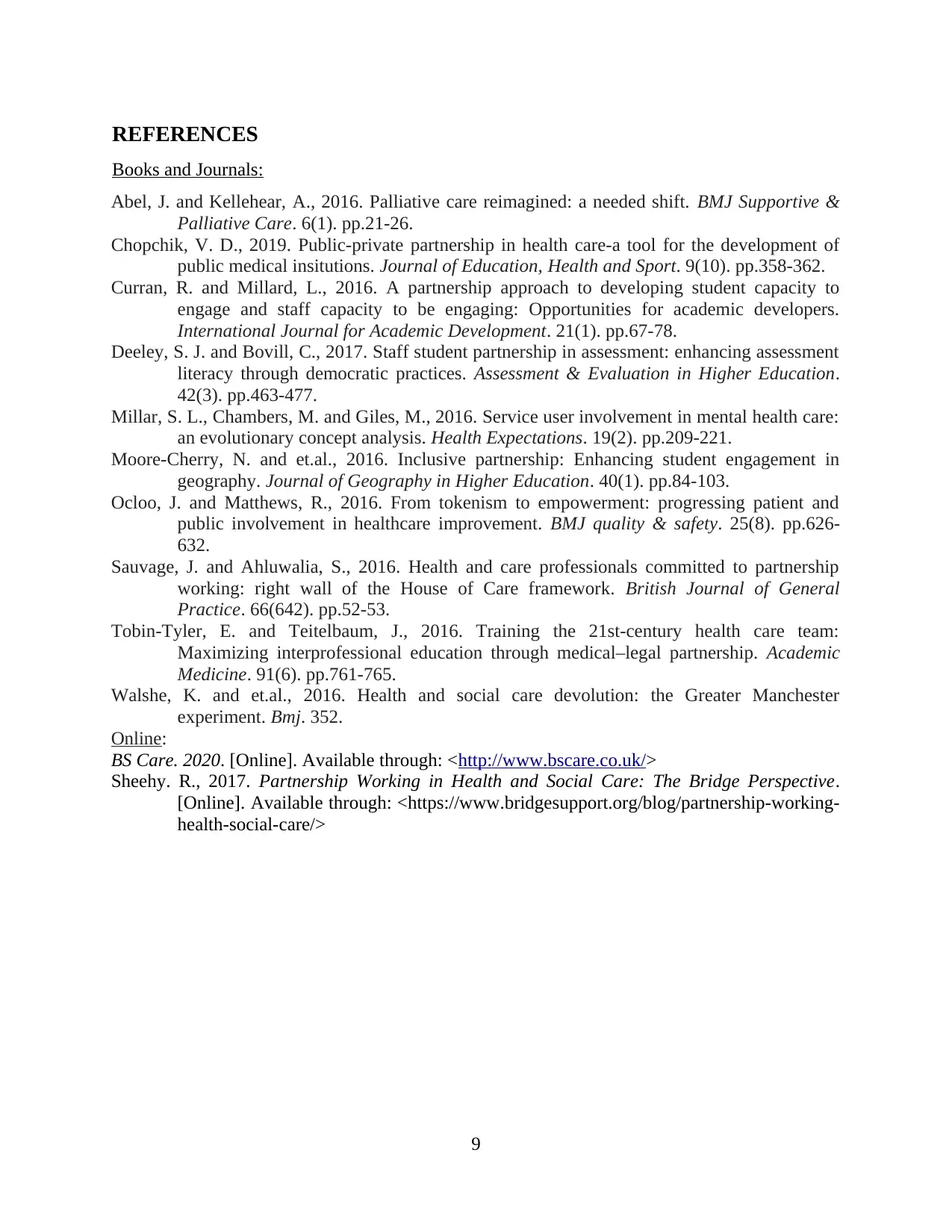
REFERENCES
Books and Journals:
Abel, J. and Kellehear, A., 2016. Palliative care reimagined: a needed shift. BMJ Supportive &
Palliative Care. 6(1). pp.21-26.
Chopchik, V. D., 2019. Public-private partnership in health care-a tool for the development of
public medical insitutions. Journal of Education, Health and Sport. 9(10). pp.358-362.
Curran, R. and Millard, L., 2016. A partnership approach to developing student capacity to
engage and staff capacity to be engaging: Opportunities for academic developers.
International Journal for Academic Development. 21(1). pp.67-78.
Deeley, S. J. and Bovill, C., 2017. Staff student partnership in assessment: enhancing assessment
literacy through democratic practices. Assessment & Evaluation in Higher Education.
42(3). pp.463-477.
Millar, S. L., Chambers, M. and Giles, M., 2016. Service user involvement in mental health care:
an evolutionary concept analysis. Health Expectations. 19(2). pp.209-221.
Moore-Cherry, N. and et.al., 2016. Inclusive partnership: Enhancing student engagement in
geography. Journal of Geography in Higher Education. 40(1). pp.84-103.
Ocloo, J. and Matthews, R., 2016. From tokenism to empowerment: progressing patient and
public involvement in healthcare improvement. BMJ quality & safety. 25(8). pp.626-
632.
Sauvage, J. and Ahluwalia, S., 2016. Health and care professionals committed to partnership
working: right wall of the House of Care framework. British Journal of General
Practice. 66(642). pp.52-53.
Tobin-Tyler, E. and Teitelbaum, J., 2016. Training the 21st-century health care team:
Maximizing interprofessional education through medical–legal partnership. Academic
Medicine. 91(6). pp.761-765.
Walshe, K. and et.al., 2016. Health and social care devolution: the Greater Manchester
experiment. Bmj. 352.
Online:
BS Care. 2020. [Online]. Available through: <http://www.bscare.co.uk/>
Sheehy. R., 2017. Partnership Working in Health and Social Care: The Bridge Perspective.
[Online]. Available through: <https://www.bridgesupport.org/blog/partnership-working-
health-social-care/>
9
Books and Journals:
Abel, J. and Kellehear, A., 2016. Palliative care reimagined: a needed shift. BMJ Supportive &
Palliative Care. 6(1). pp.21-26.
Chopchik, V. D., 2019. Public-private partnership in health care-a tool for the development of
public medical insitutions. Journal of Education, Health and Sport. 9(10). pp.358-362.
Curran, R. and Millard, L., 2016. A partnership approach to developing student capacity to
engage and staff capacity to be engaging: Opportunities for academic developers.
International Journal for Academic Development. 21(1). pp.67-78.
Deeley, S. J. and Bovill, C., 2017. Staff student partnership in assessment: enhancing assessment
literacy through democratic practices. Assessment & Evaluation in Higher Education.
42(3). pp.463-477.
Millar, S. L., Chambers, M. and Giles, M., 2016. Service user involvement in mental health care:
an evolutionary concept analysis. Health Expectations. 19(2). pp.209-221.
Moore-Cherry, N. and et.al., 2016. Inclusive partnership: Enhancing student engagement in
geography. Journal of Geography in Higher Education. 40(1). pp.84-103.
Ocloo, J. and Matthews, R., 2016. From tokenism to empowerment: progressing patient and
public involvement in healthcare improvement. BMJ quality & safety. 25(8). pp.626-
632.
Sauvage, J. and Ahluwalia, S., 2016. Health and care professionals committed to partnership
working: right wall of the House of Care framework. British Journal of General
Practice. 66(642). pp.52-53.
Tobin-Tyler, E. and Teitelbaum, J., 2016. Training the 21st-century health care team:
Maximizing interprofessional education through medical–legal partnership. Academic
Medicine. 91(6). pp.761-765.
Walshe, K. and et.al., 2016. Health and social care devolution: the Greater Manchester
experiment. Bmj. 352.
Online:
BS Care. 2020. [Online]. Available through: <http://www.bscare.co.uk/>
Sheehy. R., 2017. Partnership Working in Health and Social Care: The Bridge Perspective.
[Online]. Available through: <https://www.bridgesupport.org/blog/partnership-working-
health-social-care/>
9
1 out of 11
Related Documents
Your All-in-One AI-Powered Toolkit for Academic Success.
+13062052269
info@desklib.com
Available 24*7 on WhatsApp / Email
![[object Object]](/_next/static/media/star-bottom.7253800d.svg)
Unlock your academic potential
Copyright © 2020–2025 A2Z Services. All Rights Reserved. Developed and managed by ZUCOL.





